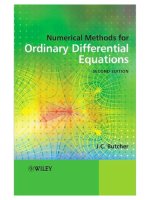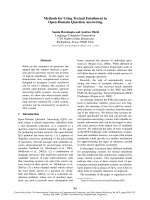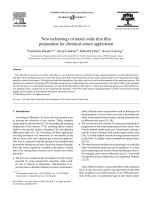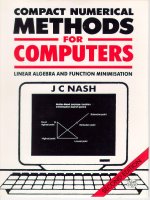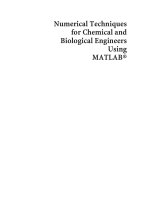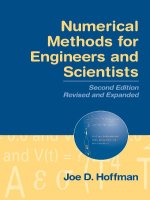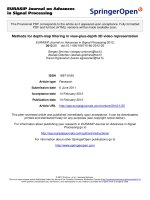NUmerical methods for chemical engineering application in matlab
Bạn đang xem bản rút gọn của tài liệu. Xem và tải ngay bản đầy đủ của tài liệu tại đây (3.91 MB, 488 trang )
This page intentionally left blank
Numerical Methods for Chemical Engineering
Suitable for a first-year graduate course, this textbook unites the applications of numerical
mathematics and scientific computing to the practice of chemical engineering. Written in
a pedagogic style, the book describes basic linear and nonlinear algebraic systems all the
way through to stochastic methods, Bayesian statistics, and parameter estimation. These
subjects are developed at a nominal level of theoretical mathematics suitable for graduate
engineers. The implementation of numerical methods in M ® is integrated within
each chapter and numerous examples in chemical engineering are provided, together with a
library of corresponding M programs. Although the applications focus on chemical
engineering, the treatment of the topics should also be of interest to non-chemical engineers
and other applied scientists that work with scientific computing. This book will provide the
graduate student with the essential tools required by industry and research alike.
Supplementary material includes solutions to homework problems set in the text,
M programs and tutorial, lecture slides, and complicated derivations for the more
advanced reader. These are available online at www.cambridge.org/9780521859714.
K J B has been Assistant Professor at MIT since 2000. He has taught extensively across the engineering discipline at both the undergraduate and graduate level. This
book is a result of the successful course the author devised at MIT for numerical methods
applied to chemical engineering.
Numerical Methods for
Chemical Engineering
Applications in MAT L A B ®
KENNETH J. BEERS
Massachusetts Institute of Technology
cambridge university press
Cambridge, New York, Melbourne, Madrid, Cape Town, Singapore, São Paulo
Cambridge University Press
The Edinburgh Building, Cambridge cb2 2ru, UK
Published in the United States of America by Cambridge University Press, New York
www.cambridge.org
Information on this title: www.cambridge.org/9780521859714
© K. J. Beers 2007
This publication is in copyright. Subject to statutory exception and to the provision of
relevant collective licensing agreements, no reproduction of any part may take place
without the written permission of Cambridge University Press.
First published in print format 2006
isbn-13
isbn-10
978-0-511-25650-9 eBook (EBL)
0-511-25650-7 eBook (EBL)
isbn-13
isbn-10
978-0-521-85971-4 hardback
0-521-85971-9 hardback
Cambridge University Press has no responsibility for the persistence or accuracy of urls
for external or third-party internet websites referred to in this publication, and does not
guarantee that any content on such websites is, or will remain, accurate or appropriate.
Contents
Preface
page ix
1
Linear algebra
Linear systems of algebraic equations
Review of scalar, vector, and matrix operations
Elimination methods for solving linear systems
Existence and uniqueness of solutions
The determinant
Matrix inversion
Matrix factorization
Matrix norm and rank
Submatrices and matrix partitions
Example. Modeling a separation system
Sparse and banded matrices
MATLAB summary
Problems
1
1
3
10
23
32
36
38
44
44
45
46
56
57
2
Nonlinear algebraic systems
Existence and uniqueness of solutions to a nonlinear algebraic equation
Iterative methods and the use of Taylor series
Newton’s method for a single equation
The secant method
Bracketing and bisection methods
Finding complex solutions
Systems of multiple nonlinear algebraic equations
Newton’s method for multiple nonlinear equations
Estimating the Jacobian and quasi-Newton methods
Robust reduced-step Newton method
The trust-region Newton method
Solving nonlinear algebraic systems in MATLAB
Example. 1-D laminar flow of a shear-thinning polymer melt
Homotopy
Example. Steady-state modeling of a condensation
polymerization reactor
61
61
62
63
69
70
70
71
72
77
79
81
83
85
88
89
v
Contents
vi
Bifurcation analysis
MATLAB summary
Problems
3
4
Matrix eigenvalue analysis
Orthogonal matrices
A specific example of an orthogonal matrix
Eigenvalues and eigenvectors defined
Eigenvalues/eigenvectors of a 2 × 2 real matrix
Multiplicity and formulas for the trace and determinant
Eigenvalues and the existence/uniqueness properties of linear
systems
Estimating eigenvalues; Gershgorin’s theorem
Applying Gershgorin’s theorem to study the convergence of iterative
linear solvers
Eigenvector matrix decomposition and basis sets
Numerical calculation of eigenvalues and eigenvectors in MATLAB
Computing extremal eigenvalues
The QR method for computing all eigenvalues
Normal mode analysis
Relaxing the assumption of equal masses
Eigenvalue problems in quantum mechanics
Single value decomposition SVD
Computing the roots of a polynomial
MATLAB summary
Problems
Initial value problems
Initial value problems of ordinary differential equations
(ODE-IVPs)
Polynomial interpolation
Newton–Cotes integration
Gaussian quadrature
Multidimensional integrals
Linear ODE systems and dynamic stability
Overview of ODE-IVP solvers in MATLAB
Accuracy and stability of single-step methods
Stiff stability of BDF methods
Symplectic methods for classical mechanics
Differential-algebraic equation (DAE) systems
Parametric continuation
MATLAB summary
Problems
94
98
99
104
104
105
106
107
109
110
111
114
117
123
126
129
134
136
137
141
148
149
149
154
155
156
162
163
167
169
176
185
192
194
195
203
207
208
Contents
vii
5
Numerical optimization
Local methods for unconstrained optimization problems
The simplex method
Gradient methods
Newton line search methods
Trust-region Newton method
Newton methods for large problems
Unconstrained minimizer fminunc in MATLAB
Example. Fitting a kinetic rate law to time-dependent data
Lagrangian methods for constrained optimization
Constrained minimizer fmincon in MATLAB
Optimal control
MATLAB summary
Problems
212
212
213
213
223
225
227
228
230
231
242
246
252
252
6
Boundary value problems
BVPs from conservation principles
Real-space vs. function-space BVP methods
The finite difference method applied to a 2-D BVP
Extending the finite difference method
Chemical reaction and diffusion in a spherical catalyst pellet
Finite differences for a convection/diffusion equation
Modeling a tubular chemical reactor with dispersion; treating
multiple fields
Numerical issues for discretized PDEs with more than two
spatial dimensions
The MATLAB 1-D parabolic and elliptic solver pdepe
Finite differences in complex geometries
The finite volume method
The finite element method (FEM)
FEM in MATLAB
Further study in the numerical solution of BVPs
MATLAB summary
Problems
258
258
260
260
264
265
270
Probability theory and stochastic simulation
The theory of probability
Important probability distributions
Random vectors and multivariate distributions
Brownian dynamics and stochastic differential equations
(SDEs)
Markov chains and processes; Monte Carlo methods
Genetic programming
317
317
325
336
7
279
282
294
294
297
299
309
311
311
312
338
353
362
Contents
viii
MATLAB summary
Problems
364
365
8
Bayesian statistics and parameter estimation
General problem formulation
Example. Fitting kinetic parameters of a chemical reaction
Single-response linear regression
Linear least-squares regression
The Bayesian view of statistical inference
The least-squares method reconsidered
Selecting a prior for single-response data
Confidence intervals from the approximate posterior density
MCMC techniques in Bayesian analysis
MCMC computation of posterior predictions
Applying eigenvalue analysis to experimental design
Bayesian multi response regression
Analysis of composite data sets
Bayesian testing and model criticism
Further reading
MATLAB summary
Problems
372
372
373
377
378
381
388
389
395
403
404
412
414
421
426
431
431
432
9
Fourier analysis
Fourier series and transforms in one dimension
1-D Fourier transforms in MATLAB
Convolution and correlation
Fourier transforms in multiple dimensions
Scattering theory
MATLAB summary
Problems
436
436
445
447
450
452
459
459
References
461
Index
464
Preface
This text focuses on the application of quantitative analysis to the field of chemical engineering. Modern engineering practice is becoming increasingly more quantitative, as the
use of scientific computing becomes ever more closely integrated into the daily activities
of all engineers. It is no longer the domain of a small community of specialist practitioners.
Whereas in the past, one had to hand-craft a program to solve a particular problem, carefully
husbanding the limited memory and CPU cycles available, now we can very quickly solve far
more complex problems using powerful, widely-available software. This has introduced the
need for research engineers and scientists to become computationally literate – to know the
possibilities that exist for applying computation to their problems, to understand the basic
ideas behind the most important algorithms so as to make wise choices when selecting and
tuning them, and to have the foundational knowledge necessary to navigate independently
through the literature.
This text meets this need, and is written at the level of a first-year graduate student
in chemical engineering, a consequence of its development for use at MIT for the course
10.34, “Numerical methods applied to chemical engineering.” This course was added in
2001 to the graduate core curriculum to provide all first-year Masters and Ph.D. students
with an overview of quantitative methods to augment the existing core courses in transport
phenomena, thermodynamics, and chemical reaction engineering. Care has been taken to
develop any necessary material specific to chemical engineering, so this text will prove
useful to other engineering and scientific fields as well. The reader is assumed to have taken
the traditional undergraduate classes in calculus and differential equations, and to have
some experience in computer programming, although not necessarily in A AB ® .
Even a cursory search of the holdings of most university libraries shows there to be a
great number of texts with titles that are variations of “Advanced Engineering Mathematics”
or “Numerical Methods.” So why add yet another?
I find that there are two broad classes of texts in this area. The first focuses on introducing numerical methods, applied to science and engineering, at the level of a junior
or senior undergraduate elective course. The scope is necessarily limited to rather simple
techniques and applications. The second class is targeted to research-level workers, either
higher graduate-level applied mathematicians or computationally-focused researchers in
science and engineering. These may be either advanced treatments of numerical methods
for mathematicians, or detailed discussions of scientific computing as applied to a specific
subject such as fluid mechanics.
ix
x
Preface
Neither of these classes of text is appropriate for teaching the fundamentals of scientific
computing to beginning chemical engineering graduate students. Examples should be typical of those encountered in graduate-level chemical engineering research, and while the
students should gain an understanding of the basis of each method and an appreciation of
its limitations, they do not need exhaustive theory-proof treatments of convergence, error
analysis, etc. It is a challenge for beginning students to identify how their own problems
may be mapped into ones amenable to quantitative analysis; therefore, any appropriate text
should have an extensive library of worked examples, with code available to serve later as
templates. Finally, the text should address the important topics of model development and
parameter estimation. This book has been developed with these needs in mind.
This text first presents a fundamental discussion of linear algebra, to provide the necessary
foundation to read the applied mathematical literature and progress further on one’s own.
Next, a broad array of simulation techniques is presented to solve problems involving
systems of nonlinear algebraic equations, initial value problems of ordinary differential
and differential-algebraic (DAE) systems, optimizations, and boundary value problems of
ordinary and partial differential equations. A treatment of matrix eigenvalue analysis is
included, as it is fundamental to analyzing these simulation techniques.
Next follows a detailed discussion of probability theory, stochastic simulation, statistics,
and parameter estimation. As engineering becomes more focused upon the molecular level,
stochastic simulation techniques gain in importance. Particular attention is paid to Brownian
dynamics, stochastic calculus, and Monte Carlo simulation. Statistics and parameter estimation are addressed from a Bayesian viewpoint, in which Monte Carlo simulation proves a
powerful and general tool for making inferences and testing hypotheses from experimental
data.
In each of these areas, topically relevant examples are given, along with A AB
www atw
r s c
programs that serve the students as templates when later writing
their own code. An accompanying website includes a A AB tutorial, code listings of
all examples, and a supplemental material section containing further detailed proofs and
optional topics. Of course, while significant effort has gone into testing and validating these
programs, no guarantee is provided and the reader should use them with caution.
The problems are graded by difficulty and length in each chapter. Those of grade A are
simple and can be done easily by hand or with minimal programming. Those of grade B
require more programming but are still rather straightforward extensions or implementations
of the ideas discussed in the text. Those of grade C either involve significant thinking beyond
the content presented in the text or programming effort at a level beyond that typical of the
examples and grade B problems.
The subjects covered are broad in scope, leading to the considerable (though hopefully
not excessive) length of this text. The focus is upon providing a fundamental understanding
of the underlying numerical algorithms without necessarily exhaustively treating all of their
details, variations, and complexities of use. Mastery of the material in this text should enable
first-year graduate students to perform original work in applying scientific computation to
their research, and to read the literature to progress independently to the use of more
sophisticated techniques.
Preface
xi
Writing a book is a lengthy task, and one for which I have enjoyed much help and
support. Professor William Green of MIT, with whom I taught this course for one semester,
generously shared his opinions of an early draft. The teaching assistants who have worked
on the course have also been a great source of feedback and help in problem-development,
as have, of course, the students who have wrestled with intermediate drafts and my evolving
approach to teaching the subject. My Ph.D. students Jungmee Kang, Kirill Titievskiy, Erik
Allen, and Brian Stephenson have shown amazing forbearance and patience as the text
became an additional, and sometimes demanding, member of the group. Above all, I must
thank my family, and especially my supportive wife Jen, who have been tracking my progress
and eagerly awaiting the completion of the book.
1 Linear algebra
This chapter discusses the solution of sets of linear algebraic equations and defines basic
vector/matrix operations. The focus is upon elimination methods such as Gaussian elimination, and the related LU and Cholesky factorizations. Following a discussion of these
methods, the existence and uniqueness of solutions are considered. Example applications
include the modeling of a separation system and the solution of a fluid mechanics boundary
value problem. The latter example introduces the need for sparse-matrix methods and the
computational advantages of banded matrices. Because linear algebraic systems have, under
well-defined conditions, a unique solution, they serve as fundamental building blocks in
more-complex algorithms. Thus, linear systems are treated here at a high level of detail, as
they will be used often throughout the remainder of the text.
Linear systems of algebraic equations
We wish to solve a system of N simultaneous linear algebraic equations for the N unknowns
x1 , x2 , . . . , x N , that are expressed in the general form
a11 x1 + a12 x2 + · · · + a1N x N = b1
a21 x1 + a22 x2 + · · · + a2N x N = b2
..
.
a N 1 x1 + a N 2 x2 + · · · + a N N x N = b N
(1.1)
ai j is the constant coefficient (assumed real) that multiplies the unknown xj in equation
i. bi is the constant “right-hand-side” coefficient for equation i, also assumed real. As a
particular example, consider the system
x1 + x2 + x3 = 4
2x1 + x2 + 3x3 = 7
3x1 + x2 + 6x3 = 2
(1.2)
for which
a11 = 1
a21 = 2
a31 = 3
a12 = 1
a22 = 1
a32 = 1
a13 = 1
a23 = 3
a33 = 6
b1 = 4
b2 = 7
b3 = 2
(1.3)
1
2
1 Linear algebra
It is common to write linear systems in matrix/vector form as
Ax = b
(1.4)
where
a11
a21
A= .
..
a12
a22
..
.
a13
a23
..
.
...
...
aN 1
aN 2
aN 3
. . . aN N
a1N
a2N
..
.
x1
x2
x = .
..
b1
b2
b = .
..
xN
(1.5)
bN
Row i of A contains the values ai1 , ai2 , . . . , ai N that are the coefficients multiplying each
unknown x1 , x2 , . . . , x N in equation i. Column j contains the coefficients a1 j , a2 j , . . . , a N j
that multiply xj in each equation i = 1, 2, . . . , N . Thus, we have the following associations,
rows ⇔ equations
columns ⇔
We often write Ax = b explicitly as
a11 a12 . . .
a21 a22 . . .
.
..
..
.
aN 1
For the example system (1.2),
aN 2
1
A = 2
3
a1N
a2N
..
.
. . . aN N
1
1
1
1
3
6
coefficients multiplying
a specific unknown
in each equation
x1
x2
.
..
b1
b2
= .
..
xN
(1.6)
bN
4
b = 7
(1.7)
2
In MATLAB we solve Ax = b with the single command, x = A\b. For the example (1.2),
we compute the solution with the code
A = [1 1 1; 2 1 3; 3 1 6];
b = [4; 7; 2];
x = A\b,
x=
19.0000
-7.0000
-8.0000
Thus, we are tempted to assume that, as a practical matter, we need to know little
about how to solve a linear system, as someone else has figured it out and provided
us with this handy linear solver. Actually, we shall need to understand the fundamental properties of linear systems in depth to be able to master methods for solving more
complex problems, such as sets of nonlinear algebraic equations, ordinary and partial
Review of scalar, vector, and matrix operations
3
differential equations, etc. Also, as we shall see, this solver fails for certain common
classes of very large systems of equations, and we need to know enough about linear
algebra to diagnose such situations and to propose other methods that do work in such
instances. This chapter therefore contains not only an explanation of how the MATLAB
solver is implemented, but also a detailed, fundamental discussion of the properties of linear
systems.
Our discussion is intended only to provide a foundation in linear algebra for the practice of
numerical computing, and is continued in Chapter 3 with a discussion of matrix eigenvalue
analysis. For a broader, more detailed, study of linear algebra, consult Strang (2003) or
Golub & van Loan (1996).
Review of scalar, vector, and matrix operations
As we use vector notation in our discussion of linear systems, a basic review of the concepts
of vectors and matrices is necessary.
Scalars, real and complex
Most often in basic mathematics, we work with scalars, i.e., single-valued numbers. These
may be real, such as 3, 1.4, 5/7, 3.14159 . . . . , or they may be complex, 1 + 2i, 1/2 i, where
√
i = −1. The set of all real scalars is denoted . The set of all complex scalars we call
C. For a complex number z ∈ C, we write z = a + ib, where a, b ∈ and
a = Re{z} = real part of z
b = Im{z} = imaginary part of z
(1.8)
The complex conjugate, z¯ = z ∗ , of z = a + ib is
z¯ = z ∗ = a − ib
(1.9)
Note that the product z¯ z is always real and nonnegative,
z¯ z = (a − ib)(a + ib) = a 2 − iab + iab − i 2 b2 = a 2 + b2 ≥ 0
so that we may define the real-valued, nonnegative modulus of z, |z|, as
√
|z| = z¯ z = a 2 + b2 ≥ 0
(1.10)
(1.11)
Often, we write complex numbers in polar notation,
z = a + ib = |z|(cos θ + i sin θ )
θ = tan−1 (b/a)
(1.12)
Using the important Euler formula, a proof of which is found in the supplemental material
found at the website that accompanies this book,
eiθ = cos θ + i sin θ
(1.13)
4
1 Linear algebra
e2 1
v2
v
v1
0
e1 1
v
e
1
Figure 1.1 Physical interpretation of a 3-D vector.
we can write z as
z = |z|eiθ
(1.14)
Vector notation and operations
We write a three-dimensional (3-D) vector v (Figure 1.1) as
v1
v = v2
(1.15)
v3
v is real if v1 , v2 , v3 ∈ ; we then say v ∈ 3 . We can easily visualize this vector in 3D space, defining the three coordinate basis vectors in the 1(x), 2(y), and 3(z) directions
as
1
0
0
e[1] = 0
e[2] = 1
e[3] = 0
(1.16)
0
0
1
to write v ∈
3
as
v = v1 e[1] + v2 e[2] + v3 e[3]
We extend this notation to define
N
, the set of N-dimensional real vectors,
v1
v2
v= .
..
(1.17)
(1.18)
vN
where v j ∈ for j = 1, 2, . . . , N . By writing v in this manner, we define a column vector;
however, v can also be written as a row vector,
v = [v1
v2 . . .
vN ]
(1.19)
The difference between column and row vectors only becomes significant when we start
combining them in equations with matrices.
Review of scalar, vector, and matrix operations
We write v ∈
N
5
as an expansion in coordinate basis vectors as
v = v1 e[1] + v2 e[2] + · · · + v N e[N ]
where the components of e[ j] are Kroenecker deltas δ jk ,
[ j]
e1
δ j1
[ j]
e2 δ j2
1,
δ jk =
e[ j] = . = .
.. ..
0,
[ j]
δjN
eN
Addition of two real vectors v ∈
N
, w∈
v1
v2
v+w = .
..
vN
as is multiplication of a vector v ∈
(1.20)
if j = k
if j = k
(1.21)
N
is straightforward,
w1
v1 + w 1
w 2 v2 + w 2
+ . =
..
..
.
wN
(1.22)
vN + w N
by a real scalar c ∈ ,
cv1
v1
v2 cv2
cv = c . = .
.. ..
vN
cv N
For all u, v, w ∈
N
N
and all c1 , c2 ∈
(1.23)
,
u + (v + w) = (u + v) + w
c(v + u) = cv + cu
u+v = v+u
(c1 + c2 )v = c1 v + c2 v
v+0 = v
(c1 c2 )v = c1 (c2 v)
v + (−v) = 0
1v = v
where the null vector 0 ∈
N
(1.24)
is
0
0
0=.
..
(1.25)
0
We further add to the list of operations associated with the vectors v, w ∈
(inner, scalar) product,
N
the dot
N
v · w = v1 w 1 + v2 w 2 + · · · + v N w N =
vk w k
k=1
(1.26)
6
1 Linear algebra
For example, for the two vectors
4
w = 5
6
1
v = 2
3
(1.27)
v · w = v1 w 1 + v2 w 2 + v3 w 3 = (1)(4) + (2)(5) + (3)(6)
= 4 + 10 + 18 = 32
(1.28)
For 3-D vectors, the dot product is proportional to the product of the lengths and the cosine
of the angle between the two vectors,
v · w = |v||w| cos θ
(1.29)
where the length of v is
|v| =
√
v·v ≥ 0
(1.30)
Therefore, when two vectors are parallel, the magnitude of their dot product is maximal
and equals the product of their lengths, and when two vectors are perpendicular, their dot
product is zero. These ideas carry completely into N- dimensions. The length of a vector
v ∈ N is
|v| =
√
N
v·v =
vk2 ≥ 0
(1.31)
k=1
If v · w = 0, v and w are said to be orthogonal, the extension of the adjective “perpendicular” from 3 to N . If v · w = 0 and |v| = |w| = 1, i.e., both vectors are normalized to
unit length, v and w are said to be orthonormal.
The formula for the length |v| of a vector v ∈ N satisfies the more general properties
of a norm v of v ∈ N . A norm v is a rule that assigns a real scalar, v ∈ , to each
vector v ∈ N such that for every v, w ∈ N , and for every c ∈ , we have
v ≥0
v =0
0 =0
if and only if (iff)
cv = |c| v
v=0
(1.32)
v+w ≤ v + w
Each norm also provides an accompanying metric, a measure of how different two vectors
are
d(v, w) = v − w
(1.33)
In addition to the length, many other possible definitions of norm exist. The p-norm, v p ,
of v ∈ N is
1/ p
N
v
p
=
|vk | p
k=1
(1.34)
Review of scalar, vector, and matrix operations
7
Table 1.1 p-norm values for the 3-D
vector (1, −2, 3)
v
p
1
2
10
50
p
6√
14 = 3.742
3.005
3.00000000009
The length of a vector is thus also the 2-norm. For v = [1 −2 3], the values of the p-norm,
computed from (1.35), are presented in Table 1.1.
v
p
= [|1| p + | −2| p + |3| p ]1/ p = [(1) p + (2) p + (3) p ]1/ p
We define the infinity norm as the limit of v
the largest magnitude of any component,
v
∞
≡ lim v
p→∞
p
p
(1.35)
as p → ∞, which merely extracts from v
= max j∈[1,N ] {|v j |}
(1.36)
For v = [1 −2 3], v ∞ = 3.
Like scalars, vectors can be complex. We define the set of complex N-dimensional vectors
as C N , and write each component of v ∈ C N as
√
v j = a j + ib j
aj, bj ∈
i = −1
(1.37)
The complex conjugate of v ∈ C N , written as v¯ or v* , is
∗
a1 + ib1
a1 − ib1
a2 + ib2
a2 − ib2
v∗ =
=
..
..
.
.
a N + ib N
(1.38)
a N − ib N
For complex vectors v, w ∈ C N , to form the dot product v · w, we take the complex
conjugates of the first vector’s components,
N
v·w =
vk∗ w k
(1.39)
k=1
This ensures that the length of any v ∈ C is always real and nonnegative,
N
v
2
2
=
k=1
vk∗ vk =
N
N
ak2 + bk2 ≥ 0
(ak − ibk )(ak + ibk ) =
k=1
(1.40)
k=1
For v, w ∈ C N , the order of the arguments is significant,
v · w = (w · v)∗ = w · v
(1.41)
8
1 Linear algebra
Matrix dimension
For a linear system Ax = b,
a11 a12 . . . a1N
a21 a22 . . . a2N
A= .
..
..
.
.
.
.
aN 1 aN 2 . . . aN N
x1
x2
x= .
..
b1
b2
b= .
..
xN
(1.42)
bN
to have a unique solution, there must be as many equations as unknowns, and so typically
A will have an equal number N of columns and rows and thus be a square matrix. A matrix
is said to be of dimension M × N if it has M rows and N columns. We now consider some
simple matrix operations.
Multiplication of an M × N matrix A by a scalar c
a11
a21
..
.
a12
a22
..
.
...
...
a M1
a M2
. . . aM N
cA = c
a1N
a2N
..
.
=
ca11
ca21
..
.
ca12
ca22
..
.
...
...
ca M1
ca M2
. . . ca M N
ca1N
ca2N
..
.
(1.43)
Addition of an M × N matrix A with an equal-sized M × N matrix B
a11
a21
..
.
...
...
a M1
. . . aM N
a1N
a2N
..
.
+
b11
b21
..
.
...
...
b1N
b2N
..
.
b M1 . . . b M N
a11 + b11 . . .
a21 + b21 . . .
=
..
.
a M1 + b M1
a1N + b1N
a2N + b2N
..
.
(1.44)
. . . aM N + bM N
Note that A + B = B + A and that two matrices can be added only if both the number of
rows and the number of columns are equal for each matrix. Also, c(A + B) = c A + cB.
Multiplication of a square N × N matrix A with an N-dimensional
vector v
This operation must be defined as follows if we are to have equivalence between the coefficient and matrix/vector representations of a linear system:
v1
a11 v1 + a12 v2 + · · · + a1N v N
a11 a12 . . . a1N
a21 a22 . . . a2N v2 a21 v1 + a22 v2 + · · · + a2N v N
Av = .
..
.. .. =
..
..
.
. .
.
aN 1
aN 2
. . . aN N
vN
a N 1 v1 + a N 2 v2 + · · · + a N N v N
(1.45)
Review of scalar, vector, and matrix operations
9
Av is also an N-dimensional vector, whose j th component is
N
(Av) j = a j1 v1 + a j2 v2 + · · · + a j N v N =
a jk vk
(1.46)
k=1
We compute (Av) j by summing a jk vk along rows of A and down the vector,
⇒
⇒
⇒ a jk
vk
⇒
Multiplication of an M × N matrix A with an N-dimensional vector v
From the rule for forming Av, we see that the number of columns of A must equal the
dimension of v; however, we also can define Av when M = N,
Av =
v1
v2
.
..
a11
a21
..
.
a12
a22
..
.
...
...
a M1
a M2
. . . aM N
a1N
a2N
..
.
a11 v1 + a12 v2 + · · · + a1N v N
a21 v1 + a22 v2 + · · · + a2N v N
..
.
=
a M1 v1 + a M2 v2 + · · · + a M N v N
vN
(1.47)
If v ∈
1
4
11
N
, for an M × N matrix A, Av ∈
2
3
12
3
2
13
M
. Consider the following examples:
1
30
4
2
1
3 = 20
130
14
4
1
3
4
5
2
1
5
6
3
14
1
2 11
2 =
6
32
3
4
29
(1.48)
Note also that A(cv) = cAv and A(v + w) = Av + Aw.
Matrix transposition
We define for an M × N matrix A the transpose AT to be the N × M matrix
AT =
a11
a21
..
.
a12
a22
..
.
...
...
a M1
a M2
. . . aM N
a1N
a2N
..
.
T
a11
a12
= .
..
a21
a22
..
.
...
...
a1N
a2N
. . . aN M
a M1
a M2
..
.
(1.49)
10
1 Linear algebra
The transpose operation is essentially a mirror reflection across
a11 , a22 , a33 , . . .. Consider the following examples:
T
1 4
1 4
1 2 3
T
1 2 3
4 5 6 = 2 5
= 2 5
4 5 6
3 6
7 8 9
3 6
the principal diagonal
7
8
9
(1.50)
If a matrix is equal to its transpose, A = AT , it is said to be symmetric. Then,
ai j = AT
ij
= a ji
∀i, j ∈ {1, 2, . . . , N }
(1.51)
Complex-valued matrices
Here we have defined operations for real matrices; however, matrices may also be complexvalued,
(a11 + ib21 ) . . . (a1N + ib1N )
c11 . . . c1N
c21 . . . c2N (a21 + ib21 ) . . . (a2N + ib2N )
(1.52)
C = .
.. =
..
..
..
.
.
.
c M1 . . . c M N
(a M1 + ib M1 ) . . . (a M N + ib M N )
For the moment, we are concerned with the properties of real matrices, as applied to solving
linear systems in which the coefficients are real.
Vectors as matrices
Finally, we note that the matrix operations above can be extended to vectors by considering
a vector v ∈ N to be an N × 1 matrix if in column form and to be a 1 × N matrix if in
row form. Thus, for v, w ∈ N , expressing vectors by default as column vectors, we write
the dot product as
w1
v · w = vT w = [v1 · · · v N ] ... = v1 w 1 + · · · + v N w N
(1.53)
wN
The notation vT w for the dot product v · w is used extensively in this text.
Elimination methods for solving linear systems
With these basic definitions in hand, we now begin to consider the solution of the linear
system Ax = b, in which x, b ∈ N and A is an N × N real matrix. We consider here
elimination methods in which we convert the linear system into an equivalent one that is
easier to solve. These methods are straightforward to implement and work generally for
any linear system that has a unique solution; however, they can be quite costly (perhaps
prohibitively so) for large systems. Later, we consider iterative methods that are more
effective for certain classes of large systems.
Elimination methods for solving linear systems
11
Gaussian elimination
We wish to develop an algorithm for solving the set of N linear equations
a11 x1 + a12 x2 + · · · + a1N x N = b1
a21 x1 + a22 x2 + · · · + a2N x N = b2
..
.
a N 1 x1 + a N 2 x2 + · · · + a N N x N = b N
(1.54)
The basic strategy is to define a sequence of operations that converts the original system
into a simpler, but equivalent, one that may be solved easily.
Elementary row operations
We first note that we can select any two equations, say j and k, and add them to obtain
another one that is equally valid,
(a j1 x1 + a j2 x2 + · · · + a j N x N = b j ) + (ak1 x1 + ak2 x2 + · · · + ak N x N = bk )
(a j1 + ak1 )x1 + (a j2 + ak2 )x2 + · · · + (a j N + ak N )x N = (b j + bk )
(1.55)
If equation j is satisfied, and the equation obtained by summing j and k is satisfied, it
follows that equation k must be satisfied as well. We are thus free to replace in our system
the equation
ak1 x1 + ak2 x2 + · · · + ak N x N = bk
(1.56)
with
(a j1 + ak1 )x1 + (a j2 + ak2 )x2 + · · · + (a j N + ak N )x N = (b j + bk )
(1.57)
with no effect upon the solution x. Similarly, we can take any equation, say j, multiply it by
a nonzero scalar c, to obtain
ca j1 x1 + ca j2 x2 + · · · + ca j N x N = cb j
(1.58)
which we then can substitute for equation j without affecting the solution. In general, in the
linear system
a11 x1 + a12 x2 + · · · + a1N x N = b1
..
.
a j1 x1 + a j2 x2 + · · · + a j N x N = b j
..
.
ak1 x1 + ak2 x2 + · · · + ak N x N = bk
..
.
a N 1 x1 + a N 2 x2 + · · · + a N N x N = b N
(1.59)
